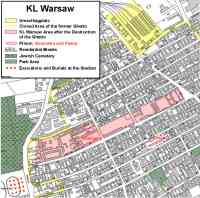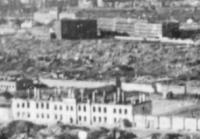The concentration camp (official German abbreviation: KL for Konzentrationslager) in Warsaw was established
on the initiative of
SS-Brigadeführer
Jürgen Stroop, the "SS- and Police Leader for the Warsaw
District" who finally liquidated the Warsaw Ghetto.
In his report of
16 May 1943, he wrote that the prisoners of this camp could be used to
clear away the
ruins and buildings on the territory of the ghetto, so as to re-use
the bricks, iron and other materials needed by industry.
Heinrich Himmler accepted this
proposal, and by
19 July 1943 Oswald Pohl,
who was responsible for the concentration camps in the "Third
Reich", was able to report to
Himmler that "KL Warschau" was already
established. The camp commandant
was
SS-Obersturmbannführer Wilhelm Goecke.
The territory of the camp consisted of the former soldiers' prison on
Gesia and
Zamenhofa Streets and the whole of
Zamenhofa,
Okopowa and
Smocza Streets. Because the prison
building was too small for all prisoners,
barracks were built in
autumn 1943. In
June 1944,
when the camp’s construction was completed, it had a capacity of 5,000 prisoners. The first
prisoners were deported to KZ Warschau from the
Reich - this was a group of 300 Germans who
became the camp’s prisoner functionaries (
Kapos). Apart from them, all the camp's other
prisoners were Jews, transferred from
Auschwitz-Birkenau.
Between August and
November 1943, 3,686 Jews were sent to KZ Warschau in four transports. Only 50 of them were Polish Jews -
the others were from Czechoslovakia, Greece, the Netherlands, France, Germany and Austria.
In
spring 1944, further transports arrived at KZ Warschau from
Auschwitz-Birkenau, among them a group of around 3,000 Jews from Hungary.
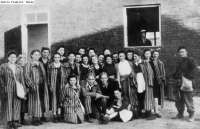 |
| Freed by AK Fighters * |
In
April 1944, KZ Warschau became a sub-camp of
Majdanek concentration camp (
"KL
Lublin"), and from then on all the staff (259 SS men) were under the command of the commandant of
KZ Majdanek.
The conditions in the camp were the same as in
Majdanek, but food was generally
worse. According to survivor's testimonies, the biggest problem in the camp was hunger. As well
as hunger, conditions in the barracks and the very hard work were the main reasons for the
high mortality in the camp. Owing to a lack of documents, it is not possible to estimate
the number of victims of this camp.
Most of the prisoners worked clearing away buildings and ruins on the site of the former
ghetto. A group of Poles also worked in the camp, but they were free workers, employed by
German companies. In
April 1944 there were 2,180 Jewish prisoners and 2,439 Polish workers
in the camp. From the site of the ghetto as a whole 34 million bricks, 7,300 kg of iron
and 805 kg of coloured metal were recovered. As well as recovery of building materials,
a special commando of prisoners was responsible for searching for gold in the ruined
buildings. On many occasions the prisoners found intact bunkers in the ruins, where Jews
from the Warsaw ghetto were still hiding. If SS men were present at such "discoveries",
those in hiding were executed immediately. Gold and money found in the former ghetto
were sent to
Majdanek and from there
to Berlin.
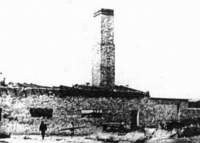 |
| The Crematorium |
A "death brigade" was also organised in the camp. This group of 20 prisoners had to burn
the bodies of those who died in the camp and of prisoners from the
Pawiak Gestapo Prison who were executed in the ghetto ruins.
The pyre for burning the bodies was in the courtyard of the house on
45 Gesia Street.
In
spring 1944 the SS ordered the building of a crematorium at
19 Zamenhofa Street. However, although the building was finished, it was
never used because on
27 July 1944 the evacuation of the camp began. On that
day the commandant announced the
evacuation and invited those who could not walk to let him know this. Around 180 prisoners decided not to go.
Together with 250 prisoners from the camp hospital they were shot.
On
28 July around 4,000 prisoners left the camp, and after four days’ marching they were
halted near
Lowicz. From there, after a five-day train journey, they were
transferred to
KZ Dachau.
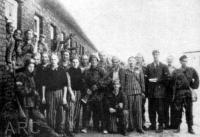 |
| Freed by AK Battalion "Zoska" |
Not all prisoners were evacuated from KZ Warschau. A group of several hundred prisoners had the
task of finally liquidating the camp. A smaller group of Polish Jews (including women) from
Pawiak prison was attached to this group. At the start of the uprising in Warsaw on
1 August 1944, the whole group numbered about 400 prisoners. On
5 August 1944, a unit
of Polish AK insurgents liberated the camp after a battle with the SS. 348 people (including 24 women)
were liberated, and most of them joined Polish insurgent units. The liberated prisoners informed
the Jewish organisations and Polish Government in Exile in
London by radio, of
their liberation. Some of them survived the Warsaw Uprising and the end of the war.
The character of KZ Warschau was typical of a labour and concentration camp.
There were no gas chambers, and most prisoners who died in the camp fell victim to the primitive living and
working conditions.
Sources:
Archive documents from State Museum Majdanek.
T. Berenstein, A. Rutkowski:
Obóz koncentracyjny dla Żydów w Warszawie (1943-1944).
(The Concentration Camp for the Jews in Warsaw 1943-1944). In: "Biuletyn Zydowskiego Instytutu Historycznego",
No. 62 (1967)
Cz. Rajca:
Podobozy Majdanka (The Sub-camps of Majdanek). In: Majdanek 1941-1944. Red. T. Mencel.
Lublin 1991.
Photo:
Powstanie Warszawskie 1944, Okiem Polskiej Kamery, by W. Jewsiewicki, and GFH
*
© ARC 2005









